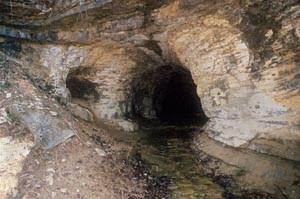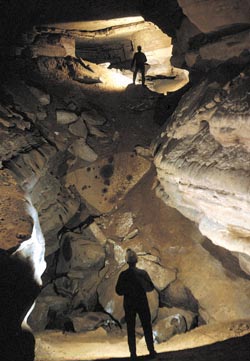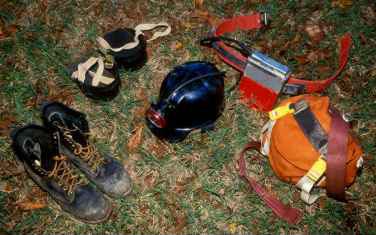
Entrance to cave in Monroe County
When you enter a cave you may have a strange feeling. This is to be expected, because you have entered an environment that is completely different from life on the surface of our planet. The majority of caves are formed in soluble rock, usually limestone or dolostone, dissolved by the action of slightly acidic water. Some cave systems have interconnecting passages that may extend for miles, but a majority of caves are short. The dampness, an occasional bat, and unusual mineral formations (speleothems) may be unfamiliar to the visitor. While many cave passages are small, others will have the visitor in awe of their vastness.
Caving is not necessarily a high-risk activity, but in certain situations and particular conditions, it can be. The level of risk involved in caving is, to a very large extent, related to the risk-taking behavior of the participants. It can also be affected by a wide variety of conditions that may be found in a cave. For the most part, caving accidents result from a lack of training, lack of proper equipment, lack of preparation, or poor judgment. Exercising good judgment will reduce the level of risk when caving.
Falls are by far the most common type of caving accident. Slow down and watch where you are stepping. Running, jumping, and other fast movements lead to risk of injury. Test handholds and footholds before committing yourself to your next move where there is a possibility of falling. Some climbs require a hand-line or belay (safety rope) controlled by a companion; free-climbing a rope (hand over hand) is foolish and could be fatal. Vertical training from a competent instructor is necessary before doing climbing in a cave.

The Big Brown Bat is one of seven bat species that use caves in Indiana.
Be aware that objects may fall while caving. Avoid unstable breakdown (fallen rock) and steep rocky slopes. Standing under anyone doing climbing or other vertical work places the caver in danger of being struck by falling rocks or cave equipment. Stay off to the side of any climber that is above and secure all loose gear to prevent dropping something on someone below. If even a small rock or piece of gear is dislodged, warn those below by shouting "ROCK!" loudly and clearly.
While traveling through a cave, narrow crevices and tight places may be encountered. Avoid forcing the body into places one cannot back out of, or where companions cannot assist the stuck person.
Getting lost in a cave can happen, but can usually be avoided by following a few simple rules. Always look behind to see what the cave will look like on the way out. Pay special attention to visualizing what junctions of passages look like. If you do happen to get lost, stay where you are and get as comfortable as possible. Conserve electric lights by turning them off for long periods. Stay alert for someone searching for you and call out occasionally to alert rescuers. A whistle carried for the purpose of signaling will help.
Always leave word with a reliable person as to what cave you will be visiting and your expected time of return. Leave an extra margin of time, as most cave trips take longer than planned. Every caver should carry three sources of light. The primary source should be attached to the hardhat or helmet. All sources of light should be durable and able to get you out of the cave. Spare parts like batteries and bulbs are required to make a light source reliable. For comfort and safety, food and drink may be very important depending on the number of hours you plan to spend in the cave.

Large canyon passageway that water has abandoned in a Monroe County Cave.
Some caves have active streams running through them and are subject to flash flooding during rainstorms. This can trap or even drown cavers. Flooding of cave passages has resulted in five of the seven deaths in Indiana caves since 1961. It is always wise to check the weather forecast before entering this kind of cave. If in doubt about the potential for a particular cave to flood, visit a different cave.
Caving is extremely physically demanding. You should be in reasonably good shape. A person in poor condition will tire quickly, slow the group, and ultimately shorten the cave trip. Know your limits and do not attempt caving beyond your capabilities. Beginners should start with short cave trips and work up to more challenging ones. Consult with an experienced caver if there is doubt about the demands of a particular cave trip.
Drugs and alcohol can be a real problem. In a caving situation where a person must be mentally alert, these substances are likely to be looked upon as something dangerous and unpopular with those whose cave trip the substance user is surely going to spoil.
Safe Caving Practices

Basic cave visiting equiptment includes sturdy shoes, knee pads, hard hat with light, gloves, and a cave pack with spare supplies and emergency equiptment.
The following list of safe caving practices is meant to help the reader, but there is nothing— and make no mistake about it— nothing that will replace using good common sense. Some items below may have already been mentioned. Additional reading on the subject is encouraged.
- Always go caving with other people (never alone).
- Wear a good-quality hardhat with a chinstrap and primary light source attached.
- Carry three sources of light.
- Always leave information with someone about where you are going and your expected time of return, allowing several hours for unexpected delays.
- Follow the lead of the more experienced caver or someone who knows the cave well.
- If all lights fail, sit down and wait for help to come.
- Avoid jumping, since cave floors are seldom level and even a short jump may result in injury.
- Practice rope work (vertical caving) under the guidance of an expert before doing any vertical caving.
- Caving can be extremely tiring; know your physical limits and watch for fatigue in others.
- Never go caving if in ill health or if you have a chronic disorder such as heart disease or epilepsy.
- Carry a small first aid kit and a large trash bag to make a heat tent using the heat from a candle or carbide lamp.
- If an immobilizing injury occurs, treat for shock (keep the injured person warm) and contact the local cave rescue organization or the State Police.
- Sitting still can cause shivering after a period of time (the first symptom of hypothermia); get moving and initiate activity.
- The slowest caver sets the pace; the leader should go only as fast as others can follow.
- If lost in a cave, panic is the worst enemy. Remain calm, conserve your light, and if you followed the rule about leaving word, you have little to worry about.
(Source: Sira undated NSS pub.)


